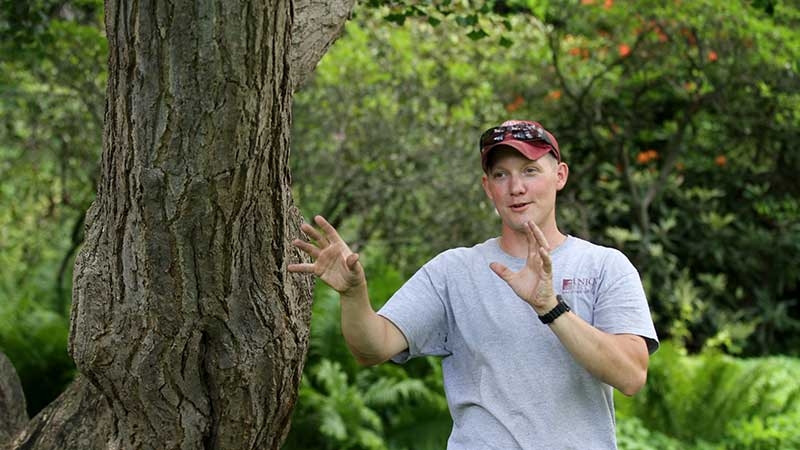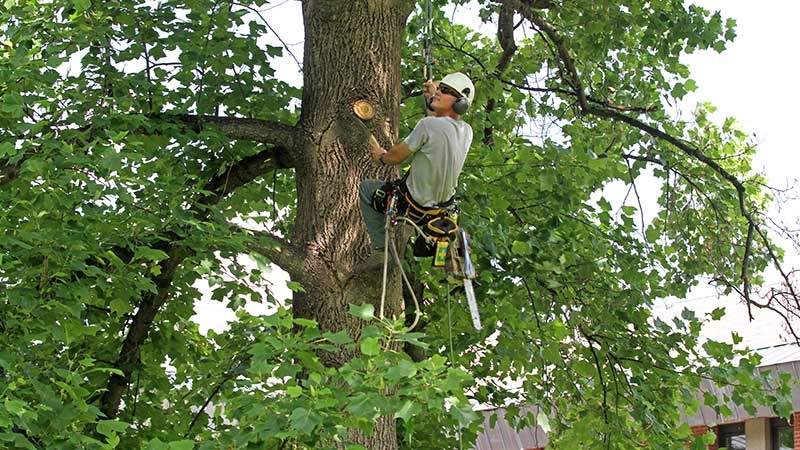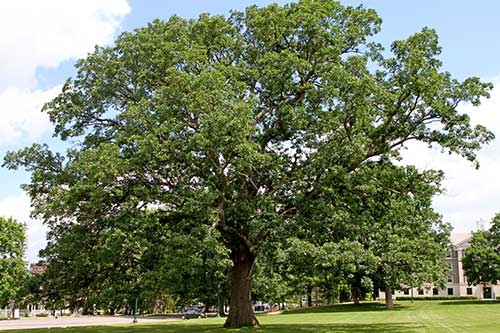College arborist Joe Conti likes to say—with equal measures of pride and humor—that “Union is like a nursing home for trees.”
Why? The College has numerous venerable old trees that deserve the utmost care.
“Here at Union, we try to keep trees around for as long as possible. Being stewards of the oldest comprehensively planned campus in the country, we work to preserve them,” Conti explained. “We have many tools at our disposal, from simply mulching to complex bracing and cabling to deep root feeding and trunk injections to fight disease or pests, we do it all. The campus is home to some impressive mature specimens and the College is willing to invest in them.”
This attitude has meant Union has developed into something of an arboretum, one that boasts approximately 100 species of trees from around the globe, from the Himalayan pine to the Persian ironwood to the black walnut native to the Northeast.
Such diversity is owed, in part, to the changes this arboretum has undergone during the last century. New buildings have necessitated the removal of trees, generous donors have gifted unique specimens, storms have caused losses, comprehensive planting efforts have been undertaken, and a scourge called Dutch elm disease did tragic damage.
The fungal infection, which first appeared in the U.S. around 1930, permanently altered the College landscape and compelled much of its re-shaping into the space we know today.
In 1952, 581 American elms trees could be found on Union’s grounds. By 1974, all but 100 had sickened and been felled, according to the Encyclopedia of Union College History. And by 1987, 75 more of the iconic elms had died.
“When I came to Union in 1967, the elm was the tree,” recalled Carl George, professor emeritus of biology. “Impressive, with a vase-like branching pattern, they were big trees, commonly five feet in diameter.”
Robert Kennedy ’65 remembers them well, too.
“Without a doubt, the gracefully soaring elms stretching along the colonnades were a dominant focus of the campus core,” he said. “Not only did they evoke an admiration for nature, but the arching branches of those majestic trees sheltered common pathways, providing shade and serenity to myriad generations of Union students.”
“Only the Nott Memorial challenged the height of the towering elms.”
The rare American elm still stands on campus, one beside Yulman Theater and another by Fero House. But these will only grow to be a shadow of what their predecessors were, before they too succumb to disease.
“We tried a variety of American elm … along New Entry Round in the early 90s, but they did not prove very resistant after all,” said Connie Schmitz, landscape specialist. “Recently, we installed a different variety between Wold and the library and hope to be more successful.”
Should it survive, the elm will join a host of amazing trees that have slowly grown to fill the gaping void left in the wake of the devastating pathogen.
Red oaks now dot Terrace Lane, for instance, and little leaf linden adorn North and South Lanes, as well as Terrace Wall Path. The addition of these, and many others, was led by the late H. Gilbert Harlow, civil engineering professor, and the late C. William Huntley ’34, professor of psychology and long-time dean of the College. According to the Encyclopedia of Union College History, by 1985, over 1,300 major shade trees, 650 flowering trees and about 5,000 shrubs and smaller trees had been planted.
Today, Joe Conti and his colleagues do their best to care for the school’s arboreal collection.
“The College’s distinctive history has left us a great inheritance of diverse and singular trees, but there is still much work to do be done, especially in continuing to replenish our inventory of trees,” Conti said. “One unique tree that will soon be reintroduced to campus is the American chestnut.”
“Practically wiped out in the early 1900s by chestnut blight, this once common tree is now a rare find,” he continued. “In the spring of 2014, Union purchased two resistant American chestnut seedlings from St. Lawrence Nurseries.”
Kennedy, who participated in a campus tree tour led by Conti during ReUnion weekend in May, was thrilled to learn his alma mater values its sylvan history as much as its academic and cultural history.
“It is gratifying to know the College has vigorously continued to replace and preserve trees in every nook of campus,” he said. “When the College preserves its trees, it sustains and affirms its link to the past and commitment to the future, all the while making the present more pleasant and beautiful.”
Indeed, the splendor and longevity of trees (Union has its centenarians.) often compel people to do more than admire these large plants. It’s easy to become attached.
Why? Perhaps it’s because trees do so much for us.
“Wood is an intensely social material, there is something powerful in sitting around a fire as a group talking, dancing, eating,” George said. “Wood has also changed our lives, giving us light, warmth and protection. It also makes tools and habitation, and paper has been extraordinarily important culturally.”
Or maybe it’s because a love of trees is stamped on our very DNA.
“I am certain that a lot of it is instinctual. The fact is, we went through very important evolutionary stages in trees,” George said. “The opposable thumb, our stereoscopic vision for estimating distance, our manual dexterity and the ability to communicate by voice across distances—a lot of what we are is a product of us being sylvan-born.”
Whatever it is about trees that captivates us so, there’s little doubt they hold special places in the hearts of many.



